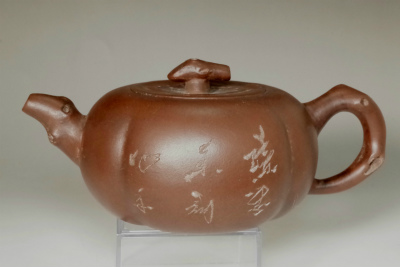Chinese ceramic type
In 609, The Asuka dynasty of Japan sent an envoy, Ono no Imoko, to the Sui Dynasty of China (589-618). The envoy brought back ceramics, calligraphy, and Buddhism and introduced Chinese advanced knowledge to Japan when they returned. The Japanese admired Chinese culture and were deeply affected by it. Diplomatic relations continued after the Sui Dynasty fell and the Tang Dynasty appeared in 619. However Japan broke diplomatic relations with China in 894 because China fell into internal disturbances called the Huang Chao Rebellion. 13 years after diplomatic relations were broken, the Tang Dynasty fell.

The Song Dynasty (937-1279) is often referred to as the golden age of Chinese ceramics. So many beautiful Chinese ceramics were imported into Japan after the Kamakura Dynasty of Japan tried to restore diplomatic relations with China. Ceramics are called ‘GIKI’ in Japanese. The word originates from ceramics from the Cizhou kiln, which flourished during the Song dynasty, similar to how the word 'china' came to mean ceramics in English. At present, Song ceramics are admired by antique ceramics collectors. Japanese refer to Ru kilns, Ding kilns, Ge kilns, Jun kilns and Guan kilns (the official kilns of China) as the five main kilns of the North Song Dynasty.
Karamono - Chinese ware
In medieval Japan, cultural items imported from Mainland China were called "karamono" and they were continuously sought after. During the Kamakura and Muromachi periods, they became highly valued as objects for decorating kaisho rooms, mainly among families positioned to accede to the shogunate and samurai families. In particular, celadon ceramics made in Longquan kilns during the Southern Song Dynasty, referred to as "bowls that reflect the sky," were mass imported in the Kamakura period and were prized as if they were national treasures. However, from China's perspective, these good were nothing more than popular wares for export. Before long, with the popularization of tea drinking, the demand for karamono increased even more. The founders of the tea ceremony, including Murata Juko and Sen no Rikyu, then took possession of these wares and created a place for them as the highest class of teaware. In Japan, celadon ceramics made in Longquan kilns are often referred to as kinuta celadon. There is a legend that this is because there is a famous vase among the pottery imported from China called the Celadon Pheonix Ear Vase that is shaped like a kinuta (a tool that is beaten to dry wet laundry quickly). There is also another legend saying that Sen no Rikyu named them this because the cracks ("hibiware") on his Celadon Orca Ear Vase reminded him of the reverbirations ("hibiki") produced by striking a kinuta.

Longquan Ware
This is the greatest kiln for celadon porcelain. The kiln was opened in the north Song era and carried on traditions from the Yue Zhou kiln. This ancient kiln continues even in the present age. Longquan was in its prime in the south Song era. Very large amounts of celadon were exported to Japan and were much admired by Japanese Tea Ceremony masters, who called the ceramics ‘kinuta’. The color of kinuta was just like jade and the shaping was very skilled. Another characteristic is that many imitated ancient Bronze shapes such as a tripod kettle or barrel.
One famous example of a Longquan ceradon bowl is named Bakohan, and is a National Treasure of Japan displayed in the Tokyo National Museum. According to a document from the Edo period this beautiful green tea bowl was made in a Longquan kiln between 1127-1279 (the South song era) and gifted from China to Japan's Taira no Shigemori in 1175.
In the Muromachi era in Japan, Bakouhan was inherited by the eighth shogun Ashikaga Yoshimasa (1435-1490) and he found cracks in the bowl. He then sent the bowl to Ming China and asked for a new bowl, the same as the one he had sent. However a potter of the Guan kiln of Ming China fixed the Shougun’s bowl and sent back, instead of a new bowl. The potter said, looking at the old bowl, “It is impossible to make such a beautiful same one again”
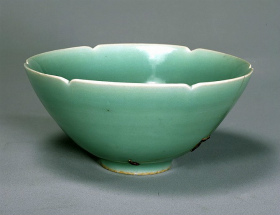
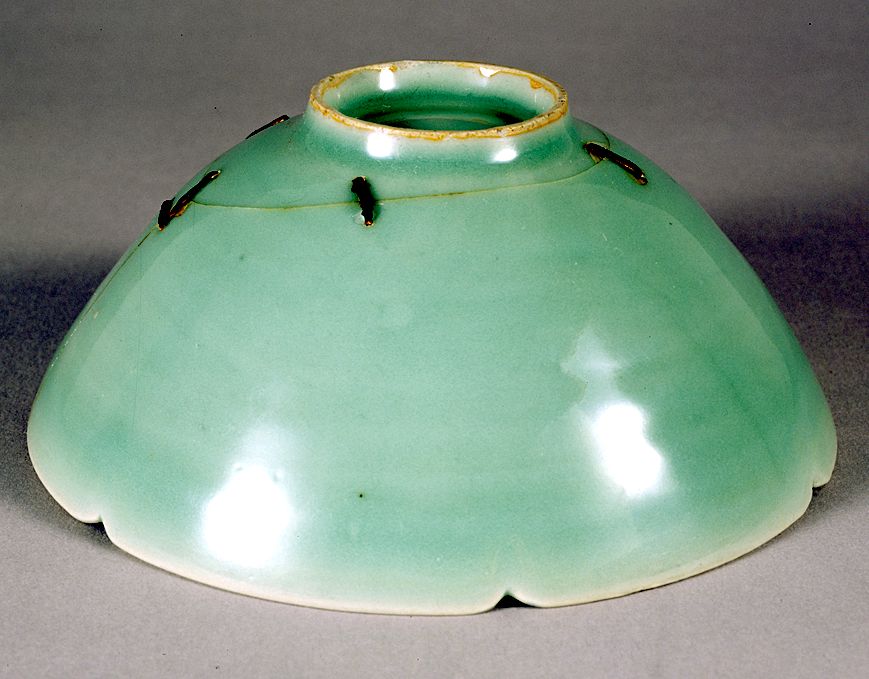
Blue and White
In 1260 the Mongolians founded the Yuan Dynasty after defeating the Jurchen of north China and the Song dynasty of south China. Unfortunately, ceramic art skills were gradually lost due to the Mongolians' lack of interest in the art. However blue and white ceramics, with a pattern of the blue drawn with cobalt on a white background, originated during this era. This was a great advance in ceramic history. The Yuan dynasty's influence extended to west Asia, so they were able to easily obtain cobalt from Islamic areas. In 1368, Chu Yuan-Chang, a leader of the Red Turban Rebellion, established a new era, the Hongwu, starting in the year he ascended to the throne in Nanjing City to found the Ming Dynasty. The Yuan Dynasty was defeated, and the production of blue and white porcelain fell away because it became difficult to obtain cobalt.
In Japan, the blue and white gave a very strong impact to Arita ware: the first porcelain product in Japanese history.
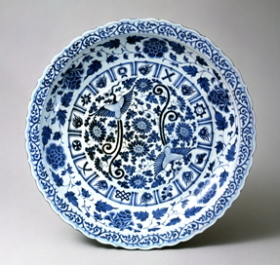
Ru Ware
Ru kilns served as purveyors to the Imperial household from 1106 to 1186. Ru ware is famous as a top-quality celadon ceramic, and features a beautiful heavenly blue. The firing method contains many mysteries. In 1987, the ruins of a Ru kiln were discovered in Henan province. The ceramics which were discovered were the same as those exhibited in the National Palace Museum and in world famous collections. Only twice has Ru ware been offered for sale at international auctions during the past few decades, but they were valued at several million dollars.
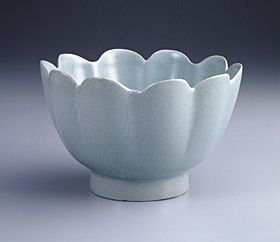
Ding Ware
Ding kilns were the only ones of the five main types which fired white ceramics. The kilns prospered in the Hebei area, the north of the Song Dynasty. Ding ware has several features such as 'dried tears' and the color 'ivory white'. 'Dried tears' are white glaze drops on the surface flowing profusely, like falling tears. 'Ivory white' is a typical Ding feature. The Ding kiln had fired ceramics with wood since the Tang dynasty. However the kiln began to use lime instead of wood at a certain time. The glaze was white tinged with blue when wood was used. The color changed to creamy white like ivory after lime began to be used. Japanese like the ivory color in spite of its blue tinge, as they consider it to be beautiful just like a precious stone.
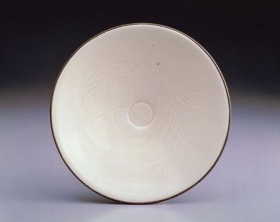
Ge Ware
Often the first Chinese pottery Japanese people come to like is Ge ware. Ge ware is a very unique celadon with a dark-brown color like bricks on the surface, and have so many craze. Ancient documents from the Ming Dynasty tell the story of two highly skilled ceramist brothers. The celadon porcelain that the older brother made was highly regarded, and the younger brother was jealous. The younger brother opened the kiln before it had completely finished firing the ceramics to look inside in order to steal the method. Fresh air flowed into the kiln and the older brother’s ceramics cracked all over. The older brother was angry, but then he noticed a deep beauty in the cracks and forgave his younger brother. The older brother reproduced the cracking and became more popular. The younger brother undertook long training and eventually founded a kiln called Longquan. He succeeded in firing very beautiful celadon.
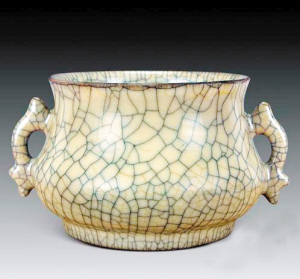
Jun Ware
Jun ware is a type of celadon. The use of straw ash in the glaze bestows its unique blue glaze suffused with white. The original Jun ware was created at the Jun kilns of Henan in the northern Song Dynasty. However the method was imitated at many other kilns because the ceramics became very popular. Ceramic ware of a similar style are called ‘Jun ware’ in the present age because so many imitations were made for so long all over China.

Guan Kilns of the Southern Song
Guan kilns refer to official kilns run directly by the government, the products of which were exclusively for the use of the imperial courts and governmental officials. Guan kilns were in use from the Song Dynasty (960-1279) to the Qing Dynasty (1644-1911). Ceramic art experienced significant growth in the south during the Song era. The Song dynasty was invaded by the Jurchen in 1126 and lost northern China, however the Imperial family ran away to south China then the dynasty was restored at Nanjing in 1127. Thus many excellent potters escaped from north to south China resulting in a blending of the two areas' styles. Celadon porcelain was fired mainly in the south Song Guan kiln and the shapes were similar to those seen in the Yao Zhou kiln (olive green glaze and hollow relief carving are characteristics of the Yao Zhou kiln) but the color was a deeper green because the potters used black soil and plenty of celadon glaze. You can see the black soil from the surface of the see-through rim. This is characteristic of the celadon porcelain made by the Guan kiln of South Song.
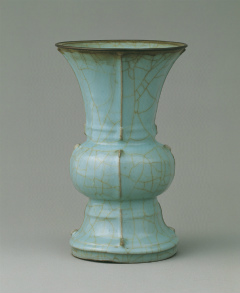
Yixing Ware
'Zisha means 'purple sand' in Chinese. This stoneware has a beautiful purple-red-brown color. It originated among potters near Yixing, who were using the local 'zisha' clay to make utensils that may have functioned as teapots in the early Song Dynasty (10th century). To the Chinese tea connoisseur, Yixing teapots were the "ideal teapot". Such fine quality teapots soon became popular and began to spread. Even now, Yixing, in Jiangsu Province, China, is known as the "Pottery Metropolis" over the world.
